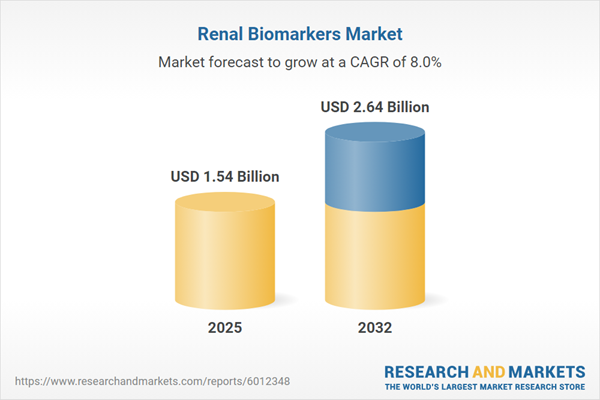Speak directly to the analyst to clarify any post sales queries you may have.
The renal biomarkers market is transforming kidney diagnostics by equipping senior decision-makers with solutions that support better patient outcomes and more streamlined operations. As organizations pursue advanced platforms and integrate innovative technologies, leaders gain new opportunities to strengthen clinical pathways and drive strategic progress.
Market Snapshot: Renal Biomarkers Market Growth and Opportunity
In 2024, the renal biomarkers market is valued at USD 1.43 billion and projected to reach USD 2.64 billion by 2032. This growth reflects ongoing demand for earlier kidney disease detection and refined risk assessment solutions. Drivers include higher adoption of multiplex testing, increased clinical and industry collaboration, and a more diverse funding ecosystem. Senior leaders are navigating a dynamic space marked by rapid platform advancements and the need for strategic, efficient resource allocation, with personalized medicine becoming a defining theme in competitive positioning.
Scope & Segmentation: Key Dynamics of the Renal Biomarkers Market
- Product Type: Diagnostic instruments, including immunoassay analyzers, mass spectrometers, and spectrophotometers, ensure robust laboratory performance. Reagents such as colorimetric and immunoassay kits, together with laboratory software, are central to workflow reliability. System integration, asset management, consulting, and training bolster compliance and quality for clinical settings.
- Biomarker Type: Albumin, creatinine, cystatin C, and NGAL remain pivotal for risk stratification and disease monitoring among varied patient populations. Biomarker choice affects treatment strategies and monitoring protocols.
- End User: The landscape includes academic institutions, contract research organizations, diagnostic laboratories, hospitals, and pharmaceutical companies, all accelerating the clinical utility and implementation of innovative renal biomarkers.
- Technology: Segment innovation is evident in biosensors, immunoassays, colorimetric analyses, and LC-MS applications. Automation and advanced analytics increase throughput and data precision, supporting demanding testing environments.
- Application: Primary applications encompass academic research, clinical diagnostics, disease surveillance, and pharmaceutical R&D. Each area benefits from seamless innovation transfer into patient management workflows.
- Sample Type: Serum, plasma, and urine offer non-invasive sampling for frequent testing—supporting wide-scale screening and chronic disease monitoring.
- Regions: Strategic approaches are influenced by local regulations, reimbursement models, and healthcare infrastructure across the Americas, Europe, Middle East, Africa, and Asia-Pacific. Each region’s healthcare dynamics shape market entry and growth strategies.
- Key Companies: F. Hoffmann-La Roche Ltd, Abbott Laboratories, Siemens Healthineers AG, Danaher Corporation, Thermo Fisher Scientific Inc., Sysmex Corporation, bioMérieux SA, Bio-Rad Laboratories Inc., Ortho Clinical Diagnostics Inc., and Quidel Corporation are driving innovation and operational improvement through global competition and expansion.
Key Takeaways for Strategic Decision-Makers
- Clinical and research collaborations accelerate the integration of renal biomarkers into diagnostic processes and support faster uptake in diverse healthcare systems.
- Alignment with evolving regulations facilitates increased clinical adoption of novel diagnostic assays and sets higher benchmarks for kidney care delivery.
- New biosensor platforms and advanced data analytics—including machine learning—offer improved risk assessment tools and enable more tailored treatment strategies for high-risk patients.
- Laboratory software and effective reagent management deliver operational flexibility, aiding laboratories as they manage increased sample volumes and more complex compliance requirements.
- Consulting and tailored informatics equip care teams to navigate both acute and chronic kidney disease management, optimizing clinical decision-making and resource use.
- Integrated diagnostic platforms—combining advanced instrumentation, analytics, and support—address evolving compliance challenges and complex workflow needs across the sector.
Tariff Impact: Navigating Trade Policies and Supply Chain Trends
Variable diagnostic tariffs and regulatory shifts reinforce the importance of flexible sourcing and collaborative supplier relationships. Adopting adaptable supply models or nearshoring can help mitigate supply chain disruptions and secure consistent access to renal testing resources.
Methodology & Data Sources
The insights presented are grounded in executive interviews, clinician feedback, rigorous analysis of peer-reviewed research, and a thorough review of regulatory frameworks. Panels of industry experts and analysis of current clinical practices ensure findings are actionable and reflect industry realities.
Why This Report Matters
- Enables decision-makers to prioritize investments with confidence by leveraging detailed segmentation and operational intelligence across the renal biomarkers value chain.
- Clarifies regional technology trends and regulatory requirements, strengthening risk management and resource allocation for executives responsible for growth initiatives.
- Supports the assessment of emerging business models and strategic partnerships that can differentiate organizations and foster sustainable market advancement.
Conclusion
Emerging technologies, evolving regulation, and new collaborations are redefining the renal biomarkers industry. This report delivers strategic analysis to help leaders make informed, future-oriented decisions in kidney diagnostics.
Additional Product Information:
- Purchase of this report includes 1 year online access with quarterly updates.
- This report can be updated on request. Please contact our Customer Experience team using the Ask a Question widget on our website.
Table of Contents
3. Executive Summary
4. Market Overview
7. Cumulative Impact of Artificial Intelligence 2025
Companies Mentioned
The companies profiled in this Renal Biomarkers market report include:- F. Hoffmann-La Roche Ltd
- Abbott Laboratories
- Siemens Healthineers AG
- Danaher Corporation
- Thermo Fisher Scientific Inc.
- Sysmex Corporation
- bioMérieux SA
- Bio-Rad Laboratories, Inc.
- Ortho Clinical Diagnostics, Inc.
- Quidel Corporation
Table Information
| Report Attribute | Details |
|---|---|
| No. of Pages | 181 |
| Published | November 2025 |
| Forecast Period | 2025 - 2032 |
| Estimated Market Value ( USD | $ 1.54 Billion |
| Forecasted Market Value ( USD | $ 2.64 Billion |
| Compound Annual Growth Rate | 7.9% |
| Regions Covered | Global |
| No. of Companies Mentioned | 11 |









